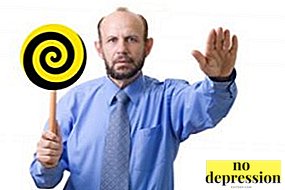Depression is not a short-term decline in mood, which should not be focused on, hoping for a quick independent recovery.
This mental disorder fraught with serious negative consequences and requires treatment, and in some cases, medication, to rule out complications.
And how can you use the reserves of the body to minimize the use of pharmaceuticals? Hypnosis for depression - A treatment method that will allow your subconscious to work on the disease.
Is it used as a treatment?

Can depression be treated with hypnosis?
Hypnosis in modern psychotherapeutic practice widely used to treat addictions, phobias, behavioral disorders, psychosomatic diseases, fatigue and irritability and, in particular, depression and anxiety.
Medieval attitude to him, as to something magical, otherworldly and inexplicable, has long sunk into oblivion, despite the fact that so far this phenomenon has not been fully studied, as well as all the hidden possibilities of our body.
According to some psychotherapists, up to 80% of the information we perceive is processed and controlled unconsciously. That is, we are aware of only 20% of what we see, hear, feel and feel. In the same way, we make decisions and react to a particular situation.
Using a hypnotic trance, a specialist can work with those patterns of our behavior and perception, the cause of which we ourselves are not fully aware of.
If we consider that quite often depression and anxiety become a consequence of low self-esteem, psychological trauma, lack of self-confidence, we can say that hypnosis is an effective tool for treating these disorders.
Hypnosis session for depression in this video:
What are the features of this method?

Trance is the natural state of each personin which each of us spontaneously flows many times throughout the day.
Probably, each of us can remember how while reading a book or watching an interesting movie, the TV program could not hear how someone from his relatives calls him.
Negative auditory hallucination - when a person does not hear clearly loud sounds - one of the many phenomena of the trance state.
Being in it, a person concentrates on some one aspect of the situation, internal experiences, memories, and ideas come to the fore, while the rest of reality is no longer the dominant factor in perception. Also in this state, learning occurs much faster.
Hypnologist causes and uses hypnotic trance to help a person concentrate on the problem, find those or other causes of depression, referring to our unconscious, which accommodates all the experience we have acquired since early childhood.
This allows a specialist to work out with his client new ways of reacting in a given situation, to get rid of ineffective patterns of behavior and perception.
In other words, hypnotherapist works with the patient's attention, directing it at the right time on the right track to reassess the situation that led to the depression.

At the same time, the possibilities of the patient himself are used, his innate ability to correctly use his own experience, including negative, in various situations.
As a rule, these abilities are enough to Significantly improve well-being with depression and develop the necessary skills to overcome the stressful situations that caused it.
Indications and contraindications for use
Since trance is the natural state of man, there are no contraindications for hypnosis depression.
In the trance state, a person can get a lot of positive emotions, gain new experience, recuperate - all this will help to cope with depression, facilitate its flow.
The exception can only be bias towards hypnosisas such, the fear of “entrusting one’s consciousness” to another person, fear of one’s own reactions in a trance state, submission to another’s will — although in fact a hypnotherapist cannot inspire a person with which he will not internally agree — this suggestion will be rejected unacceptable.
Tactics and methods of entering into a trance

The tactics of entering hypnotic trance are many, and their effectiveness for each person will be different - in this regard, the specialist often chooses which one to apply in a particular case.
The most commonly used methods are:
- Direct suggestions. Such suggestions are used in authoritarian, directive hypnosis, when the hypnotherapist, using his authority, gives the immediate commands to go into trance. Further work is also based on this principle - the hypnologist gives a command, which is performed by the patient.
This technique works well with receptive people who are prone to suggestions.
- Fixation on any subject - a pendulum, a hand of a hypnotist, etc. At the same time, the attention of the patient is kept on the above-mentioned objects, along with the necessary suggestions are given. It is also possible to fix attention on an imaginary subject.
- The method of "confusion." This method of input into the hypnotic trance is based on the need for a person to get out of the state of cognitive overload that a hypnologist causes. At the same time, for example, they are called several statements, with each of which, individually, the patient can agree, but in the general context they contradict each other. This causes confusion in the patient and the need to somehow resolve the incomprehensible situation. At this point, the specialist and given the necessary settings to enter into a trance.
 Pattern break. With this method, the hypnologist chooses any patterned pattern of behavior (it can be both verbal and non-verbal), for example, a handshake, a greeting — what we do “on the machine” and expect the same reaction from others — and at some point produces an inappropriate action that also causes confusion and a trance state in a patient, after which the required suggestions are made.
Pattern break. With this method, the hypnologist chooses any patterned pattern of behavior (it can be both verbal and non-verbal), for example, a handshake, a greeting — what we do “on the machine” and expect the same reaction from others — and at some point produces an inappropriate action that also causes confusion and a trance state in a patient, after which the required suggestions are made.- Age regression. This method is especially effective when you want to refer to the past of the patient. At the same time, the hypnologist mentions the action that we perform every day - for example, we have dinner, and it is stated that all the days are similar to each other - Monday is Saturday, and Wednesday is Friday, one week is another, June is March, and May is February - we have dinner every evening, but separately we can single out the New Year's Eve dinner, which occurs from year to year. Then, significant dates are mentioned - for example, the patient's birthdays, by means of which the memories are transferred to an earlier period - until childhood, after which the therapeutic work begins.
As a rule, a good specialist has in his arsenal a variety of similar techniques and selects them in each individual case depending on the nature and temperament of his patient.
Work stages
In a hypnosis session, the following stages are distinguished:
 Rappot installation. When working, the hypnotherapist should first achieve a good rapport - that is, to establish proper contact with the patient, a level of mutual understanding with him and confidence. There are many similar methods - the adoption of patient settings, the mirroring of posture during a conversation, the adjustment of breathing, and others. And only after the rapport is established, proceed to the next stage.
Rappot installation. When working, the hypnotherapist should first achieve a good rapport - that is, to establish proper contact with the patient, a level of mutual understanding with him and confidence. There are many similar methods - the adoption of patient settings, the mirroring of posture during a conversation, the adjustment of breathing, and others. And only after the rapport is established, proceed to the next stage.- Trance induction. At this stage, the specialist enters the patient into a trance state, using one of the techniques, and also determines the depth of the trance in one way or another.
- Therapeutic work. After induction of trance, direct work on the causes of depression occurs, effective behavioral patterns are worked out, patients often relax, learning to receive positive emotions, using their own imagination or memories. In the process of this work, post-hypnotic suggestions are also given - those settings that the patient will use after leaving the hypnotic state.
- Exit trance. After the necessary work has been done, the hypnotherapist makes a suggestion to leave the trance state, monitors the patient's sense of comfort and, if necessary, assigns the next session.
The number of hypnosis sessions in each case of depression treatment can vary greatly. As a rule, the duration of treatment is determined by the hypnotherapist himself.
Efficiency

Does hypnosis help with depression?
The effectiveness of the hypnotherapist in many ways depends on the patient's desire to recover.
Without his certain assistance to achieve a good result is extremely difficult, since the treatment of hypnosis involves, first of all, the ability of the patient.
Only interest in recovery, gaining psychological health will be a decisive factor in the effectiveness of hypnosis, as a tool to combat depression.
Meditation exercises
Use the benefits of trance in the treatment of depression can and independently doing meditative practices or relaxation techniques.
At the same time, a feeling of calmness, relaxation, composure, harmony with the outside world is achieved, which allows a person to accept the situation as it is.
And, as you know, the first step in solving any problem is the acceptance of the problem itself, and not its denial.
In the treatment of hypnosis specialist refers to those the patient’s natural abilities that are easier to manifest in a state of trance.

Often, a person cannot experience joy and good emotions, as he adheres to the attitude that every new situation poses a danger or disappointment.
Hypnologist bypassing such an installation can turn to the patient's subconsciouswho knows, from childhood, that she can deal with adversity, adapt to various situations and receive satisfaction from life.
Meditation "Fighting Depression":

 Pattern break. With this method, the hypnologist chooses any patterned pattern of behavior (it can be both verbal and non-verbal), for example, a handshake, a greeting — what we do “on the machine” and expect the same reaction from others — and at some point produces an inappropriate action that also causes confusion and a trance state in a patient, after which the required suggestions are made.
Pattern break. With this method, the hypnologist chooses any patterned pattern of behavior (it can be both verbal and non-verbal), for example, a handshake, a greeting — what we do “on the machine” and expect the same reaction from others — and at some point produces an inappropriate action that also causes confusion and a trance state in a patient, after which the required suggestions are made. Rappot installation. When working, the hypnotherapist should first achieve a good rapport - that is, to establish proper contact with the patient, a level of mutual understanding with him and confidence. There are many similar methods - the adoption of patient settings, the mirroring of posture during a conversation, the adjustment of breathing, and others. And only after the rapport is established, proceed to the next stage.
Rappot installation. When working, the hypnotherapist should first achieve a good rapport - that is, to establish proper contact with the patient, a level of mutual understanding with him and confidence. There are many similar methods - the adoption of patient settings, the mirroring of posture during a conversation, the adjustment of breathing, and others. And only after the rapport is established, proceed to the next stage.

